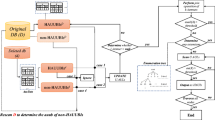Abstract
Traditional association-rule mining only concerns the occurrence frequencies of the items in a binary database. In real-world applications, customers may buy several copies of the purchased items. Other factors such as profit, quantity, or price should be concerned to measure the utilities of the purchased items. High-utility itemsets mining was thus proposed to consider the factors of quantity and profit. Two-phase model was the most commonly way to keep the transaction-weighted utilization downward closure property, thus reducing the numerous candidates in utility mining. Most methods for finding high-utility itemsets are used to handle a static database. In practical applications, transactions are changed whether insertion, deletion, or modification. Some itemsets may arise as the new high-utility itemsets or become invalid knowledge in the updated database. In this paper, a maintenance Fast Updated High Utility Pattern tree for transaction MODification (FUP-HUP-tree-MOD) algorithm is thus proposed to effective maintain and update the built HUP tree for mining high-utility itemsets in dynamic databases without candidate generation. Experiments are conducted to show better performance of the proposed algorithm compared to the two-phase algorithm and the HUP tree algorithm in batch mode.


















Similar content being viewed by others
References
Abdullah Z, Herawan T, Deris M (2010) Mining significant least association rules using fast slp-growth algorithm. Lect Notes Comput Sci 6059:324–336
Agrawal R, Imielinski T, Swami A (1993) Database mining: a performance perspective. IEEE Trans Knowl Data Eng 5:914–925
Agrawal R, Srikant R (1994) “Fast algorithms for mining association rules in large databases.” The Int Conf Very Large Data Bases: 487–499
Chan R, Yang Q, Shen YD (2003) “Mining high utility itemsets,” IEEE Int Conf Data Min: 19–26
Chen MS, Han J, Yu PS (1996) Data mining: an overview from a database perspective. IEEE Trans Knowl Data Eng 8:866–883
Cheung DWL, Han J, Ng V, Wong CY (1996) “Maintenance of discovered association rules in large databases: An incremental updating technique.” Int Conf Data Eng:106–114
Cheung DWL, Lee SD, Kao B (1997) “A general incremental technique for maintaining discovered association rules.” The Int Conf Database Syst Adv Appl: 185–194
Frequent itemset mining dataset repository. Available: http://fimi.ua.ac.be/data/ (2012)
Gharib TF, Nassar H, Taha M, Abrahamd A (2010) An efficient algorithm for incremental mining of temporal association rules. Data Knowl Eng 69:800–815
Han J, Pei J, Yin Y, Mao R (2004) Mining frequent patterns without candidate generation: a frequent-pattern tree approach. Data Min Knowl Disc 8:53–87
Hong TP, Lin CW, Wu YL (2008) Incrementally fast updated frequent pattern trees. Expert Syst Appl 34:2424–2435
Hong TP, Lin CW, Wu YL (2008) “An efficient fufp-tree mainteance algorithm for record modification,”. Int J Innov Comput Inf Control 4:2875–2887
Li YC, Yeh JS, Chang CC (2005) Direct candidates generation: a novel algorithm for discovering complete share-frequent itemsets. Fuzzy Syst Knowl Discov 3614:551–560
Li YC, Yeh JS, Chang CC (2005) “Direct candidates generation: A novel algorithm for discovering complete share-frequent itemsets.” Lect Notes Comput Sci: 551–560
Li YC, Yeh JS, Chang CC (2005) “A fast algorithm for mining share-frequent itemsets.” Lect Notes Comput Sci: 417–428
Lin CW, Hong TP, Lu WH (2009) The pre-fufp algorithm for incremental mining. Expert Syst Appl 36:9498–9505
Lin CW, Hong TP, Lu WH (2010) “Maintaining high utility pattern trees in dynamic databases.” Int Conf Comput Eng Appl: 304–308
Lin CW, Hong TP, Lu WH (2011) An effective tree structure for mining high utility itemsets. Expert Syst Appl 38:7419–7424
Lin CW, Lan GC, Hong TP, Kong L (2014) Mining high utility itemsets based on transaction deletion. Lect Notes Electr Eng 260:983–990
Lin CW, Lan GC, Hong TP (2012) An incremental mining algorithm for high utility itemsets. Expert Syst Appl 39:7173–7180
Liu Y, Liao WK, Choudhary A (2005) “A two-phase algorithm for fast discovery of high utility itemsets.” Adv Knowl Discov Data Min: 689–695
Liu M, Qu J (2012) “Mining high utility itemsets without candidate generation>” ACM Int Conf Inf Knowl Manag: 55–64
Liu J, Wang K, Fung BCM (2012) “Direct discovery of high utility itemsets without candidate generation.” IEEE Int Conf Data Min: 984–989
Microsoft. Example database foodmart of microsoft analysis services. Available: http://msdn.microsoft.com/en-us/library/aa217032(SQL.80).aspx
Nath B, Bhattacharyya DK, Ghosh A (2013) “Incremental association rule mining: A survey,” WIREs Data Mining Knowledge Discovery, vol. 3
Song W, Liu Y, Li J (2013) “Mining high utility itemsets by dynamically pruning the tree structure.” Appl Intell: 1–15
Tseng VS, Bai-En S, Cheng-Wei W, Yu PS (2013) Efficient algorithms for mining high utility itemsets from transactional databases. IEEE Trans Knowl Data Eng 25:1772–1786
Wu CW, Lin YF, Yu PS, Tseng VS (2013) “Mining high utility episodes in complex event sequences.” ACM Int Conf Knowl Discov Data Min: 536–544
Yao H, Hamilton HJ (2006) Mining itemset utilities from transaction databases. Data Knowl Eng 59:603–626
Yao H, Hamilton HJ, Butz CJ (2004) “A foundational approach to mining itemset utilities from databases.” SIAM Int Conf Data Min: 211–225
Yuna U, Ryanga H, Ryub KH (2014) High utility itemset mining with techniques for reducing overestimated utilities and pruning candidates. Expert Syst Appl 41:3861–3878
Acknowledgments
This research was partially supported by the Shenzhen Peacock Project, China, under grant KQC201109020055A, by the Natural Scientific Research Innovation Foundation in Harbin Institute of Technology under grant HIT.NSRIF.2014100, and by the Shenzhen Strategic Emerging Industries Program under grant ZDSY20120613125016389.
Author information
Authors and Affiliations
Corresponding author
Rights and permissions
About this article
Cite this article
Lin, CW., Zhang, B., Gan, W. et al. Updating high-utility pattern trees with transaction modification. Multimed Tools Appl 75, 4887–4912 (2016). https://doi.org/10.1007/s11042-014-2178-9
Received:
Revised:
Accepted:
Published:
Issue Date:
DOI: https://doi.org/10.1007/s11042-014-2178-9




